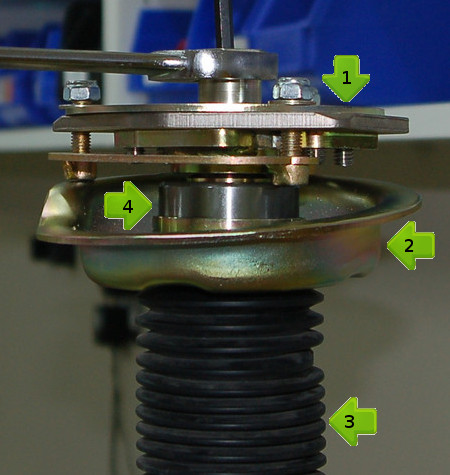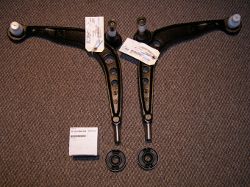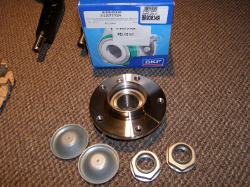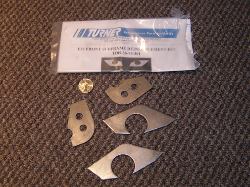Saturday, July 16, 2011
Control Arms Research
I spent a good amount of time in the past two weeks researching my front suspension options. The first item on the agenda was control arms. My original plan was to install 1995 M3 control arms. My latest research confirmed that the arms are correct for my application and that I should use centered bushings with these arms.
The main difference between the stock and M arms is that the outer ball joint is rubber encapsulated, in that there is a thin ring of rubber between the outer metal ring that is pressed into the arm and the ball joint itself. BMW did this to eliminate noise and vibration, but the unfortunate and predictable side effect is a reduction in steering feel and an increased risk of failure, particularly on the track.
I also confirmed that the stock ball joint is replaceable while the M equivalent is not, but that's not a limiting factor since most people acknowledge that when it's time to replace the outer ball joint it's just cheaper to install a new arm.
While on the same topic, I discovered that most control arms from the various flavors of the E30 and E36 have the same geometry. The notable exception is the 96-99 M3 arm, which adds caster. The 95 M3 achieved the same thing with offset control arm bushings to push the kingpin a bit farther forward in the wheel well and enhances the effect with offset strut supports that push the top of the strut backward. Since I have no need for increased caster on this car I plan to install the centered bushings from the 96-99 M3. This will allow me to preserve the stock non-M geometry and gain the strength and feel of the M3 ball joints.
My research additionally confirmed something I'd known instinctually for some time: that the solid control arm bushings should only be used with the solid ball joints of the M arms. Mixing and matching will result in increased wear and premature failure of the weaker parts.
Camber Plates Research
As you may recall, my original justification for camber plates on this car was to dial out the eccentricity of my shock towers in both caster and camber. A close second goal was to be able to run anywhere from 1.5 to 2.0 degrees of negative camber to dial out some understeer. Back then, my preliminary research revealed that Vorshlag was at the top of the heap so I naturally assumed I'd buy them and went about my business.
Since the use of camber plates affects other parts choices and because I always try to spend my money wisely, I decided to look more deeply into my camber plate options before I pulled the trigger. I will not admit exactly how much time I spent researching this topic last weekend, but let's just say I needed a shave afterward. I found lots of conflicting information being reported by both users and vendors, some of it understandable given the myriad options including strut and spring types, track and street applications, and new vs. second hand parts. Frankly, I found it difficult to decipher who was telling the truth based on real world experience and who was trying to sell me something, but I'll try to relay what I learned.
First, some nomenclature. As shown in the adjacent picture (Source: Vorshlag), you can see the camber/caster plate at the top (Arrow 1). Below that is the upper spring perch (Arrow 2), in this case Vorshlag's proprietary equivalent of the stock OE perch, and below that is the strut (Arrow 3). You may note the beefy double-row ball bearing that is provided with the perch (Arrow 4). Note: The spring is missing this picture.
The stock strut mounts are designed with a bearing surrounded by a large rubber isolation bushing which helps reduce coupling of noise and vibration from the road surface transmitted by the strut to the shock tower. You can clearly see the bushing by popping the hood and looking at the top of the shock towers. The bearing type utilized in the mount differs based on the suspension type. The standard suspension mount uses a simple plain bearing, while both the sport package non-M and M3 mounts utilize a ball bearing. When you realize that the entire strut -- and therefore the strut rod -- turns as the wheel is turned, the need for a bearing in this location, as well as the merits of a ball bearing relative to a plain bearing become clear.
 Unfortunately, with the exception of one vendor's
offering, all the camber plate designs eliminate the isolation bushing in favor
of a spherical bearing of some sort to reduce flexing of the struts that can
change alignment in unfavorable ways during aggressive turning or braking.
No matter what way you slice it, no matter how much the vendors try to sugar-coat
this issue, the reality is the use of camber plates will result in increased
NVH (for the noobs, this refers to any undesired characteristic in the areas
of Noise, Vibration, or Handling). The overwhelming majority of people pointed
out that the Vorshlag plates are the quietest in this respect, but the more
honest folk admitted that NVH can be an issue with ANY plate. It's just that
the vast majority of people who use these places use them on the track and
simply either don't hear the noise through the helmet or accept it in return
for the increased performance camber plates afford them.
Unfortunately, with the exception of one vendor's
offering, all the camber plate designs eliminate the isolation bushing in favor
of a spherical bearing of some sort to reduce flexing of the struts that can
change alignment in unfavorable ways during aggressive turning or braking.
No matter what way you slice it, no matter how much the vendors try to sugar-coat
this issue, the reality is the use of camber plates will result in increased
NVH (for the noobs, this refers to any undesired characteristic in the areas
of Noise, Vibration, or Handling). The overwhelming majority of people pointed
out that the Vorshlag plates are the quietest in this respect, but the more
honest folk admitted that NVH can be an issue with ANY plate. It's just that
the vast majority of people who use these places use them on the track and
simply either don't hear the noise through the helmet or accept it in return
for the increased performance camber plates afford them.
Some other honest people also admitted that spherical-bearing designs are susceptible to damage from potholes. If the strut ever bottoms out, it loads the spherical bearing in a way it was not designed to accept. Depending on the severity and frequency of the strikes, the bearing can loosen up or break entirely, leaving the owner to deal with clicks and/or clunks until they get the time to pull the struts and install new plates (or new parts assuming the vendor sells them separately...not all do). I couldn't underestimate the potential impact (no pun) of this problem on both my vehicle and wallet. The fact that I'm concerned about this and that I'm no cheapskate when it comes to this car should tell you something.
Most people seemed to recommend three vendors: Vorshlag, Ground Control, and TC Kline. There were a few other vendors mentioned, but let's just say they weren't mentioned in a positive light. Just so I don't have to listen to those manufacturers (or their legal representation) whine they'll remain nameless. Here's a summary of the pros and cons of the most popular brands:
Vorshlag
Pros:
- Soundly engineered and appear to be made from quality materials.
- Best online reputation including good technical support.
- Reasonable technical data and quality photos available on the website.
- Support for stock springs with their proprietary spring perch.
- Oversized spherical bearing in the plate, large double-row ball bearing in the perch (a definite upgrade from stock).
Cons
- Not compatible with the stock spring perches.
- Not infinitely adjustable in caster, which means they won't allow me to make the minor adjustments necessary to correct for my out-of-rig shock towers.
- Plate design requires the strut to be removed from the vehicle and the plate partially disassembled to change the caster setting. To their credit, most people (including track rats) set caster and forget it because changing it requires a new alignment.
- Spring perches and a couple other parts are cadmium plated, which means they'll rust solid in NJ winters. I could prep and paint them but the obvious question arises: I'm paying $440 for these parts. Why the hell am I finishing them? It's not like powder coating or a coat of zinc chromate primer and a gloss black finish would cost that much. I expect aircraft-quality finishes at these prices.
Ground Control
Pros
- Long history supporting BMWs (they were allegedly the first to bring camber plates to the E36).
- Good reputation for quality parts -- many people suggested I'd be equally happy with Vorshlag or GC.
- Several versions of the plates are available to suit the application (street, hybrid, and race) because GC recognizes that race parts don't always work well on street cars and vice versa.
- Camber and caster are infinitely adjustable.
- Quality Aurora (US-sourced) bearings.
Cons
- A high percentage of people complain about noise or rattling with these plates. To GC's credit, this may be related to the fact that until recently they offered only the equivalent of their "race" plates which are primarily designed for track cars. Also, it was clear to me that there is a critical washer needed for some applications that some people fail to install, usually because they acquire the plates used and without that washer. I would not buy any plate used, but if I did, I'd check with GC in particular to make sure I had the correct parts for my application.
- Deal breaker for me: neither the race nor the hybrid plates are compatible with stock springs (they are compatible with coilovers only), which leaves me with the street plates, but...
- The street plates use a urethane bushing and what appears to be a plain bearing. First of all, while urethane bushings have their applications, I'd prefer a preloaded high durometer rubber bushing in this application. I don't care about strut deflection on a street car -- I want isolation. The bearing is also a step backward from stock. Why would I replace a ball bearing with a plain bearing? That's a downgrade.
TC Kline
Pros
- Reputation precedes the company. No question people respect the brand, but given the $550 price for the plates I'd expect nothing less.
- Thick reinforcement on the top of the plate takes the place of the shock tower reinforcement plate available from BMW. This is a plus because the BMW plate can sometimes interfere with camber plates in general.
- Camber and caster are infinitely adjustable.
Cons
- According to the website, the plates work with "most" springs, including stock E36 M3 / non-M. I emailed them through their website (as they don't publish their email address) to confirm my application and they never responded.
- A simple google search reveals the first 10 hits are for people selling these plates. Not sure what to make of that. Probably a fluke, but maybe not.
- These are probably equivalent to the Vorshlag or GC Race plate by design. Still not sure that's a good choice for a street car.
- They advertise that the plates allow a change in camber over a range of 1.5 degrees without affecting toe. I'm no suspension engineer so I looked around and found that's not possible. If you change caster or camber, the geometry of the suspension will always cause a change in toe. In fact, as camber becomes more negative, toe deviates from positive (wheels pointing inward) to negative (wheels pointing outward). Most track rats take advantage of this fact by aligning toe to be slightly positive at a camber setting appropriate for the street (like -1.0 degrees) so that as the plate is adjusted for increased negative camber at the track the toe goes slightly negative....which is exactly what you want for improved turn-in.
- Did I mention the price?
Conclusion
Sadly, all the research did was to confirm that camber plates are designed primarily for track applications and really have no business being on a street car, at least as the vast majority of the plates are currently designed and finished. The lack of isolation between the strut and the strut tower begs for damage to the plate, the strut tower, or both. I understand that race parts are designed for a particular mission and isolation isn't one of them, but it seems to me there is a market for a camber plate meeting all of my requirements. GC comes the closest to my ideal with their street plates, but they made some design decisions I don't like on those units.
The end result is that I'll be skipping the camber plate installation and installing new OE strut supports. If I ever decide to "retire" this car to the track and transition to coilovers of some kind, I can always install a set of plates at that time. For now, I don't need a caster adjustment and the stock camber (-1.0 degrees) is, as they say, good enough for government work. And it's probably just as well, as I'm sure I'll find somewhere else to spend that $500.
Front End Overhaul - First Parts Arrived
I placed an order with Turner Motorsport for their E36 front subframe reinforcement kit and, because they were $50 cheaper ($100 total savings), a set of their SKF OEM front hub assemblies, wheel nuts and protection caps. Total for that order was $300. While inspecting the bearings I became concerned about the fact that the ABS trigger ring looked nothing like any other E36 or E46 trigger ring I'd ever seen. I double-checked the part number on the box and confirmed with Turner that I do indeed have the correct parts. Since I'm a "measure twice and cut once" kind of guy, I'll double-check that with my technician before installing them.
I also made what has become a ritual appearance at my dealer and ordered the 1995 M3 control arms, 96-99 bushings, and related hardware because there are no OEM equivalents available. When the parts came in late in the week and I went to pay for the invoice I found a woman complaining to the cashier about paying $12 for a bulb. I asked the woman if she wanted to trade invoices and looked at the cashier and smiled. When the woman heard the cashier rattle off my $460 obligation, the woman smiled and said "uh, no". All I could say was "I wish my average invoice here was $12". That seemed to diffuse the situation. Some people don't know how lucky they are.
Next on the list is the X-Brace with associated nutserts and installation tool, brake hoses, sway bar links, engine mounts, strut tower reinforcements, strut assemblies, and everything necessary to overhaul the steering column. Without the camber plates, and assuming the brake pistons aren't pitted (which would necessitate new or overhauled calipers because the pistons aren't separately available), I'm estimating $2500 in parts for the project.
Mileage: 209900, Parts: $760, Parts Saved: $200






